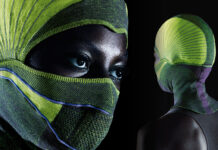United Kingdom
As graduate collections were revealed for 2022, KIC caught up with a selection of new talent who demonstrate the variety and breadth of creativity this cohort has to offer.
Tanya Evans-Lawes: ‘Ropes And Ladders’
BA (Hons) Fashion Knitwear and Knitted Textiles, Nottingham Trent University
Knitwear designer Tanya Evans-Lawes has fuelled her graduate collection with twenty years of hand knitting experience and a particular interest in Fair Isle and Ganseys. Enjoying the technical side of garment making and fabric creation, Tanya has explored Stoll and Shima Seiki knitting techniques alongside her hand-crafted making. Victorian photographs by Frank Meadow Sutcliffe of fishermen and their knitting families in Whitby (where Tanya used to live) formed her initial inspiration.
Re-purposed knits such as Fair Isle from Shetland and sone Ganseys have been combined with hand knit techniques such as ‘steeking’ to secure and cut the knits, piecing and patchworking them together in unusual ways. Lace developments on Shima Seiki machines are combined with laying in techniques to emulate the feel of woven fabrics.
Fibre choice was inherent to the origin of Tanya’s project, “It was important for me to use only wool. When knitting a collection inspired by the traditional knitting of the British Isles it seemed appropriate. I enjoyed using 5 ply Gansey yarn as it’s spun to be durable and almost feels like cotton.”
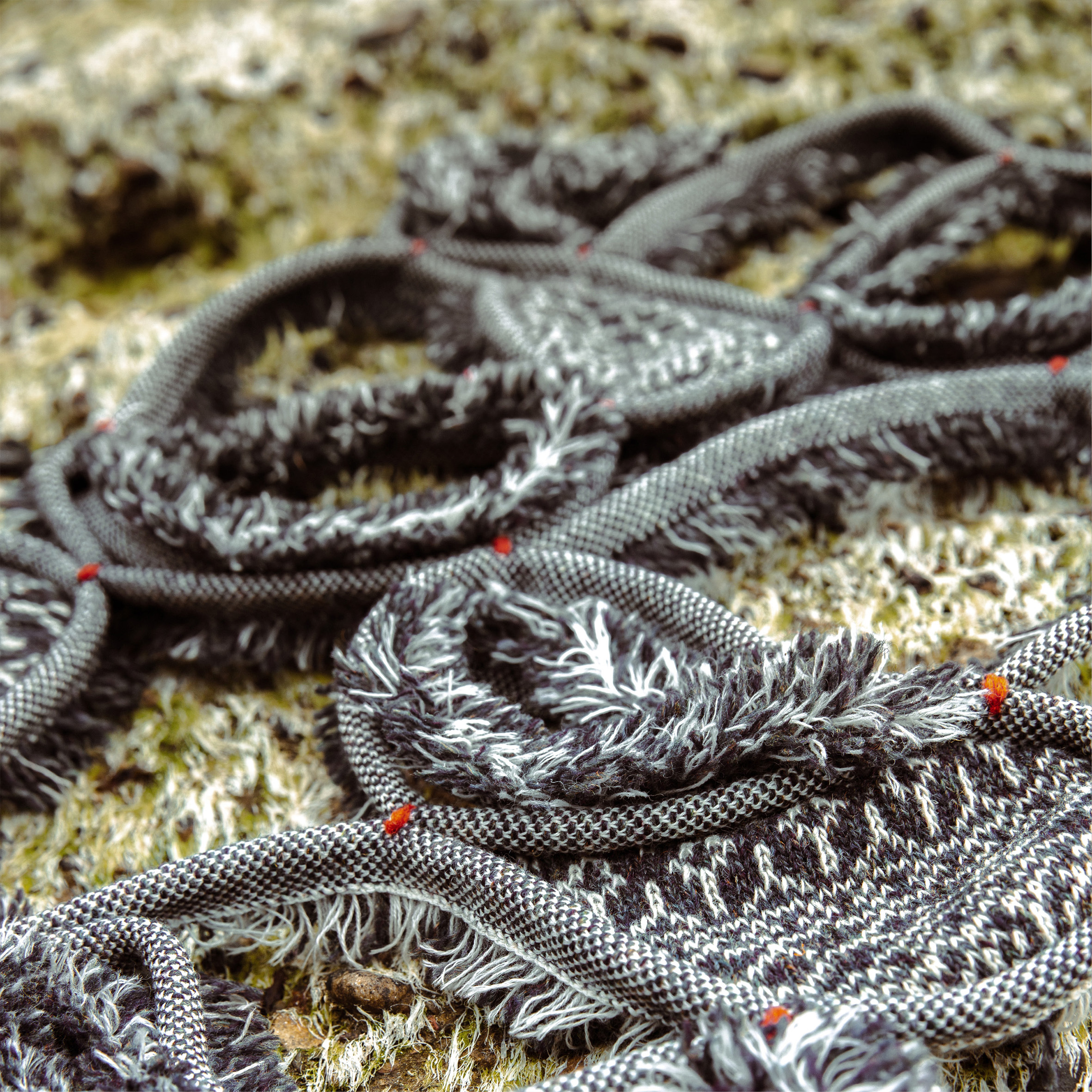
Sustainability was an important consideration for Tanya, “I was inspired by the construction of a traditional Gansey. They’re knitted with future repairing in mind (the sleeves are knitted from the shoulder down so when the cuff wears out they can easily be unravelled and re-knitted). They are made durable by using a special Channel Island cast on and super strong 5 ply spun wool. I believe these sustainable elements of a Gansey are great inspiration for sustainable knitwear design of the future.”
The biggest challenge in achieving this sustainable outcome herself was the repurposing of pre-existing garments. Problem solving was at the heart of Tanya’s design development process as she achieved zero-waste making methods on her re-purposed pieces- but had limited amounts of fabric to work with.
Awarded a bursary for her project by The Worshipful Company of Framework Knitters as well as being shortlisted for the BFC X Net-a-porter Vanguard Education Fund and the Sustainability Award at Fashanne, her collection has gained industry recognition. Tanya hopes to start her own re-purposed knitwear brand whilst continuing to develop the relationship between her digital and hand knit practice.
Tanya’s Instagram: @adventuresinyarn
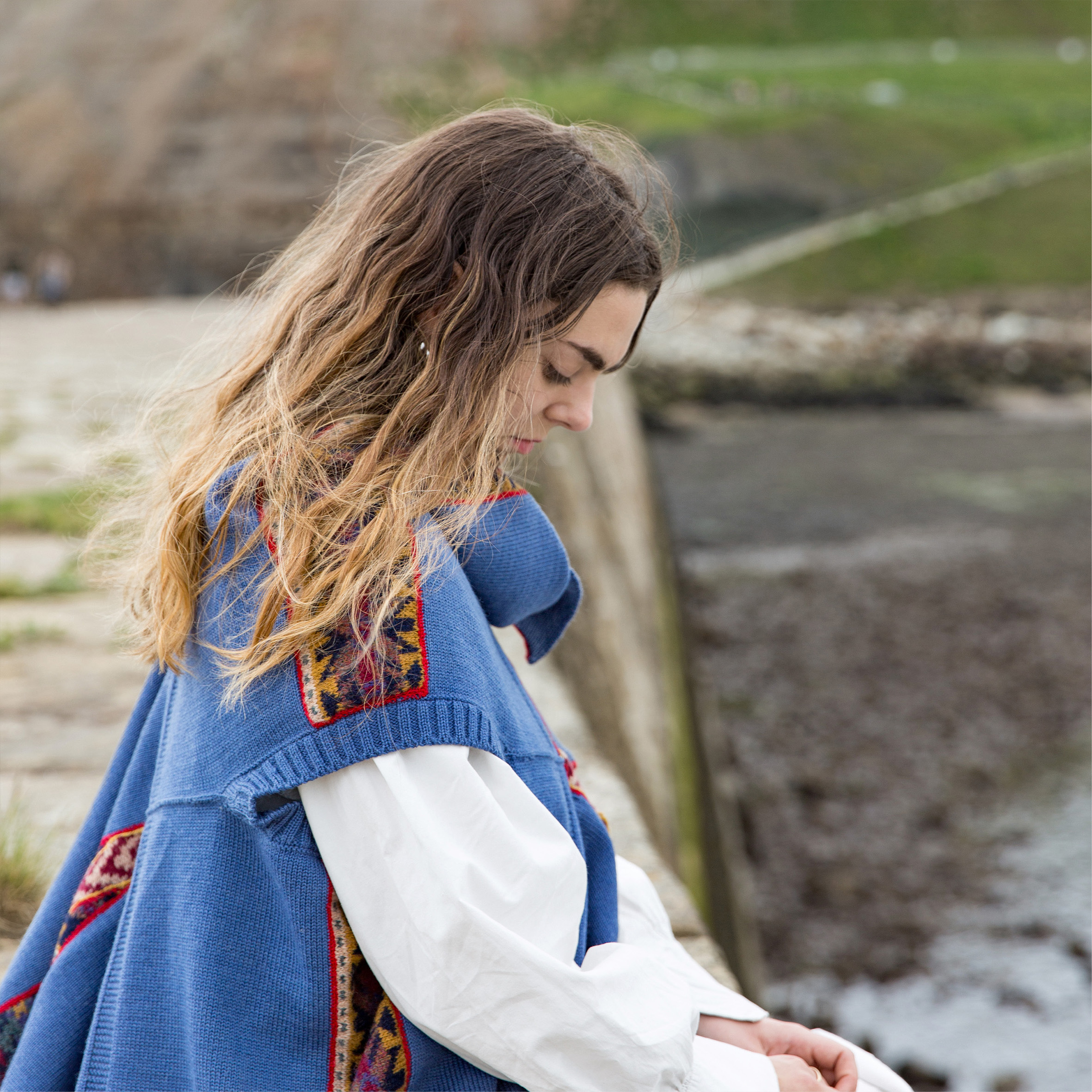
Cordelia Saville-Smith: ‘Mother: the mythology and creation of pearls’
BA Textile Design, Knit, UAL Central Saint Martins
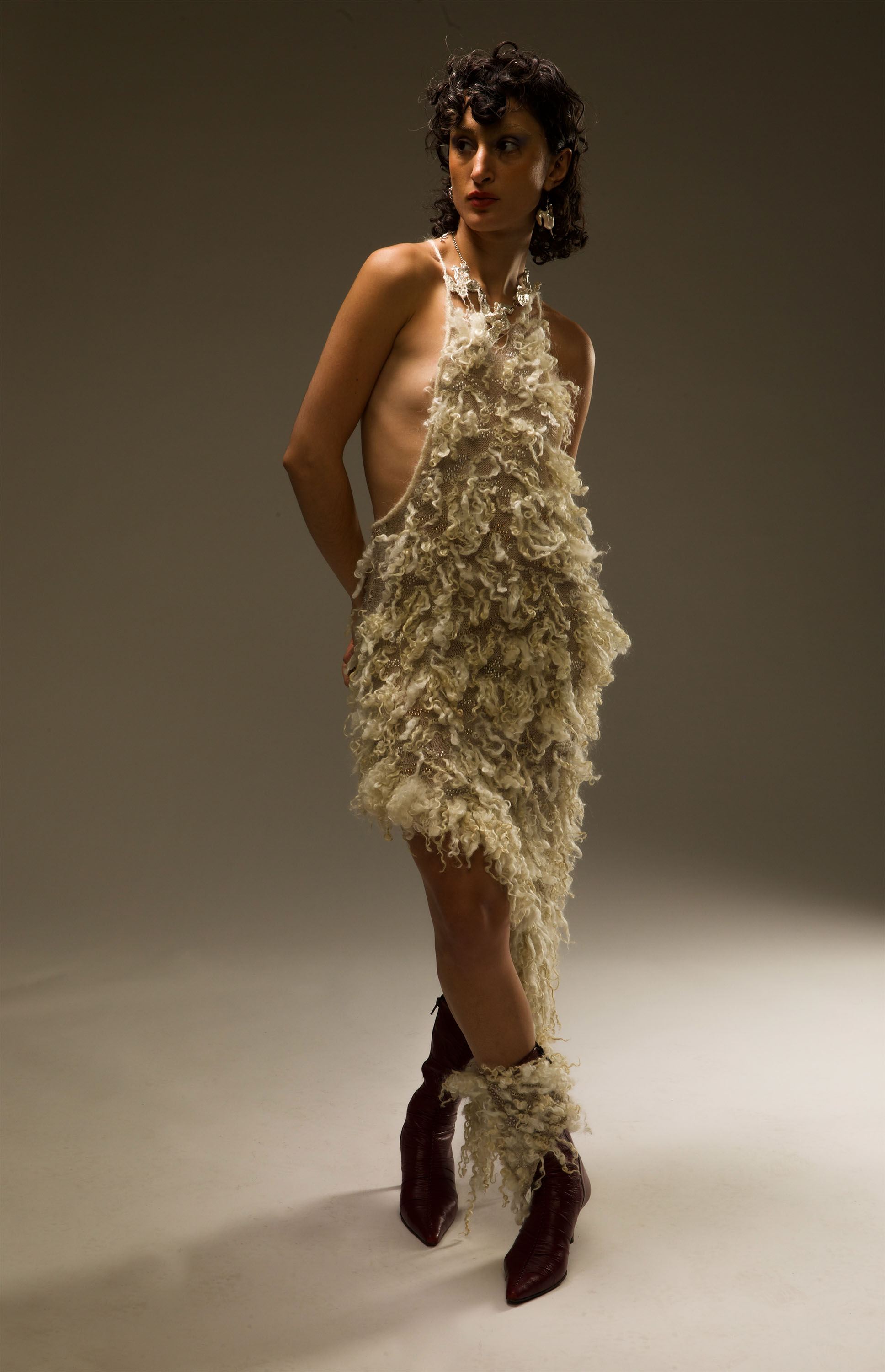
Knitwear designer Cordelia’s time intensive knitted garments are adorned with beads and detailed trims within her graduate collection ‘Mother: the mythology and creation of pearls’. Inspired initially by the way pearls are represented within mythology she explored the Japanese concept that pearls are ‘the tears of mermaids’. Her research processes led to a connection between pearls and fertility, “I loved the idea that oysters would come to the surface of the ocean at night and catch a raindrop which it would then take back down to the ocean bed and ‘fertilise’. There are a lot of connotations between pearls and fertility. My research then went much more into the actual ways in which they are created…I didn’t know before that anything could become a pearl if it gets trapped inside the shell of a mollusc. This spurred my research and I began doing a lot more material development and looking at different ways of trapping.”
Achieving sponsorship from Loro Piana allowed Cordelia to work with fine silk yarns, echoing the luxury pearlescence of her research. Combined with this she used Teeswater Locks and deadstock monofilament to achieve contrasts in fullness and transparency. Collaborating with a fellow student, Cordelia was able to put her theory that clothing is a form of jewellery into practice, “I collaborated with jewellery student Elena Maria Moedlinger as I knew I wanted to incorporate jewellery within my collection. I designed a necklace, which Elena then beautifully executed, it’s made from solid silver and stone set Keishi pearls.”

Cordelia’s ‘Nacre’ shirt was made from Loro Piana yarn ‘Exodus’ combined with monofilament. It is fully reversable as well as separatable into two pieces to become a bolero and corset. Her ‘Teeswater dress’ knitted on the domestic knitting machine is representative of a pearl in its final form. The beading and Teeswater fleece placement intentionally flows across the body with the necklace attached to the dress using crochet and blanket stitch.
The biggest challenge facing Cordelia was the time constraint associated with such detailed, hand-crafted work. A testament to her hard work and dedication, she achieved what she set out to and plans to develop the project further in future by incorporating 3D printing. Hoping to join a brand whose values align with hers, Cordelia aims to gain valuable experience to take forwards into her own brand one day.
Cordelia’s Instagram: @cordiesavillesmith
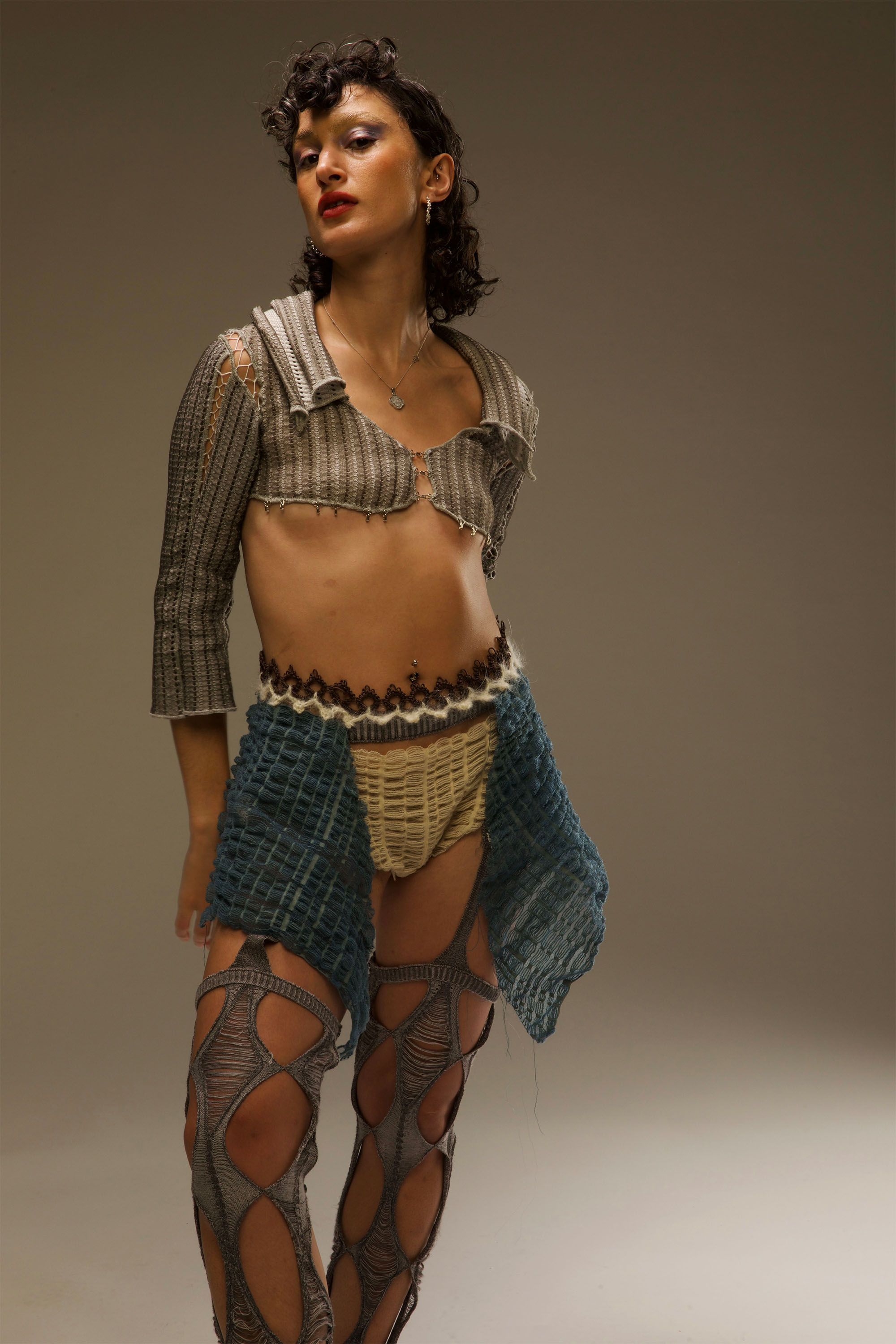
Emily Warne: ‘Granny’s attic’
BA (Hons) Fashion Knitwear Design and Knitted Textiles, Nottingham Trent University

Knitwear designer Emily is driven by a focus on pattern and colour. Her work explores contrasts in prints, colours and texture in a maximalist style. Combining hand knit and crochet skills with fine gauge flat-bed knits, Emily also utilises the graphic abilities of power knitting. This combination of hand-crafted with digital forms exciting knitted outcomes, “At the heart of my designs is my interest in craft. I care deeply about the quality and longevity of the pieces I make, creating clothes that are cherished and kept beyond trends.”
Emily’s collection is formed upon her research into theory surrounding taste, “The idea of an object or aesthetic being able to move between taste categories has always fascinated me. My collection encompasses a maximalist, kitsch, and playful feeling. The collection’s look is akin to a child going into their granny’s attic and playing dress up. It focuses on nostalgia, taking inspiration from photographs and objects that I associate with my Grannies.”
A collection built on contrasts, Emily’s garments are engineered with mismatched fabrics and ideas, echoing childlike nostalgia with technical sophistication. “By juxtaposing fabric qualities, like clashing the sheer and shiny quality of rayon with the soft and chunky texture of mohair, the collection is playful. The soft approach that is referenced in brushed mohair intarsias emulates nostalgia. This is then contrasted with graphic, crisp jacquards referencing my modern take on craft and ‘granny chic’.”
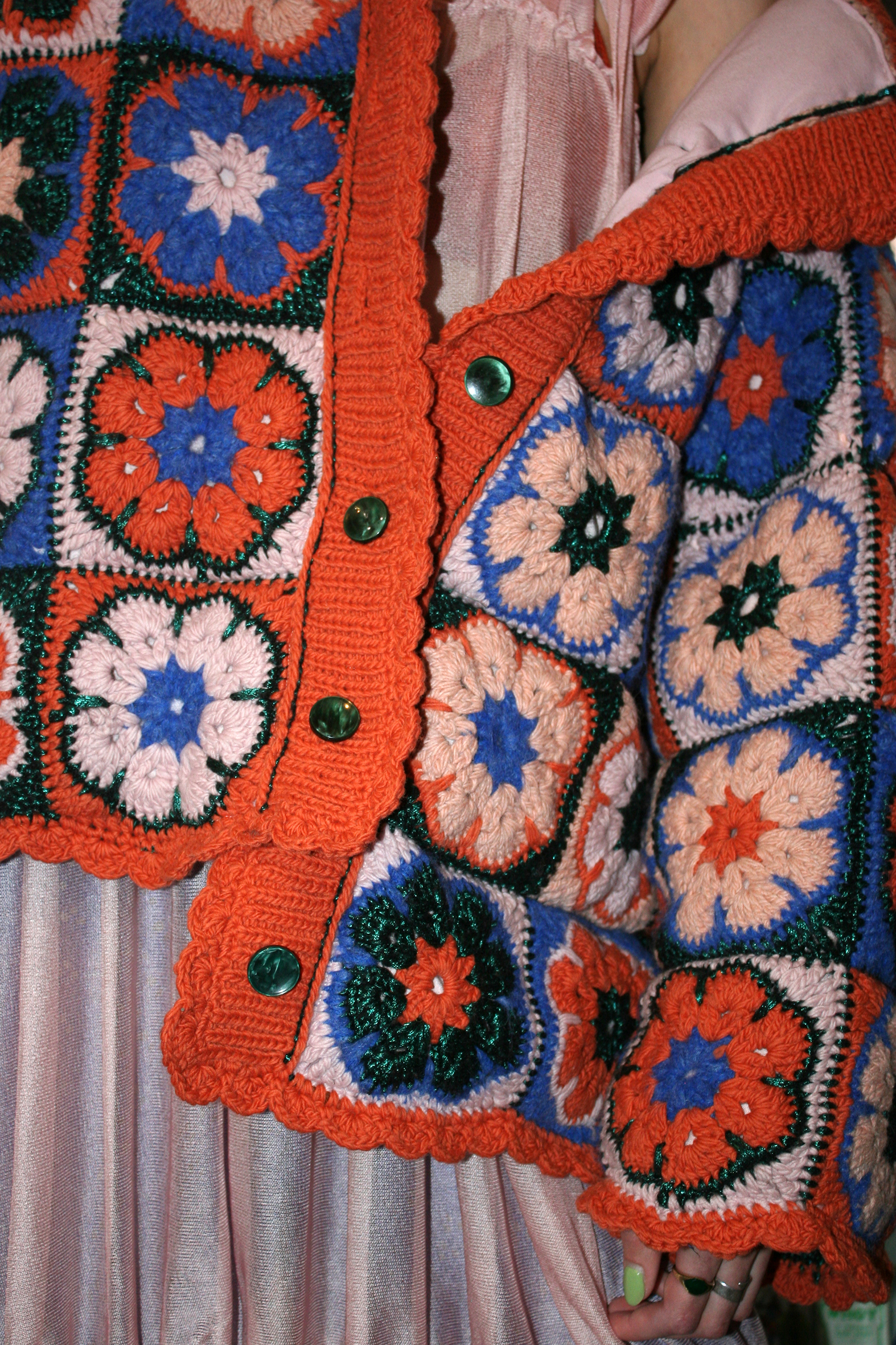
Achieving UPW sponsorship enabled Emily to utilise sustainably sourced yarns within her collection, as well as incorporating deadstock yarns. It was the inclusion of rayon which generated challenges for Emily to overcome, due to the slippery nature of the yarns, “The fabric wasn’t suitable for the overlockers as the overlocking stitch was too large to properly catch and secure all the stitches in the single bed fabric. My fabric panels had to be either finished on the Babylock machine or to linked off point to point – a time consuming process.”
Emily’s collection has been awarded the Fashanne 2022 Knitwear Award as well as being shortlisted to the final twelve for the Graduate Fashion Week Portfolio Award. Encouraged by these commendations, Emily is looking to work within a swatch studio or knit studio that focuses on longevity in design creations, whilst maintaining her love of knitting.
Emily’s Instagram: @ems.knit

Evelyn Wang: ‘Untie Me’
BA (Hons) Fashion Textiles: Knit, UAL London College of Fashion

Knitwear designer Evelyn takes inspiration from expressing emotions reflecting on herself, “I am committed to exploring the relationship between body, knit and garment through the study of patterns, colors and materials.” Evelyn’s graduate collection ‘Untie Me’ is a truly personal collection inspired by her own experiences with body anxiety. The collection seeks to portray a narrative of the growth of reconciliation and self-healing. Through a series of self-portraits, she visually interpreted different states of mind. She also researched the history of women’s lingerie. Symbols of femininity such as flowers and bows as well as the Chinese symbolism associated with vases and beauty inspired her to explore the concept of untying bows, seen as a sign of female liberation. “I see the untying of the bow as a metaphor for breaking free. I hope that women can break free from the label of bondage and explore their own unique charms.”
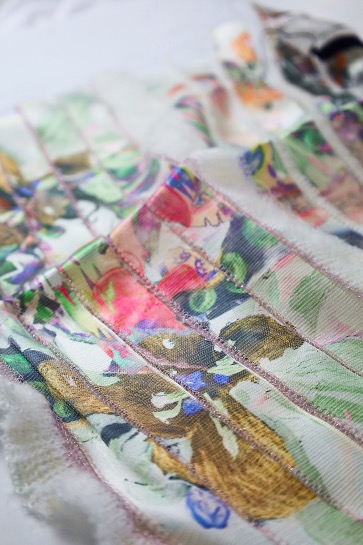
Evelyn’s fabrics showcase experimental heat press techniques, transforming her paintings into printed knits. Crochet methods are combined with the use of polyester bonding to create voluminous silhouettes with feminine trims and details. For her printing methods, polyester fibre content achieved the most saturated, colour fast outcomes during her experimentation. Interesting surface patterns were also achieved through the exploration of printing on ‘fluffier’ yarns too. Elastane was incorporated to facilitate stretch and form whilst ribbons and monofilament were utilised as print bases too. Evelyn combined these materials with a range of making techniques from 8-12 gauge Dubied fabrics to Stoll, hand knit, laser cut and crochet processes.
Speaking of her appreciation for the creatives she collaborative with in the styling and photography of her collection, Evelyn shared, “Through this practice, I have opened myself up to the importance of sharing ideas, broadening my horizons and learning how to communicate and work together in a team, which is essential for my future studies and work at MA.” Evelyn is going on to study an MA in Textiles at the Royal College of Art and hopes to one day set up her own knitting studio in China to develop innovative fashion fabrics.
Evelyn’s Instagram: @evely.nwang
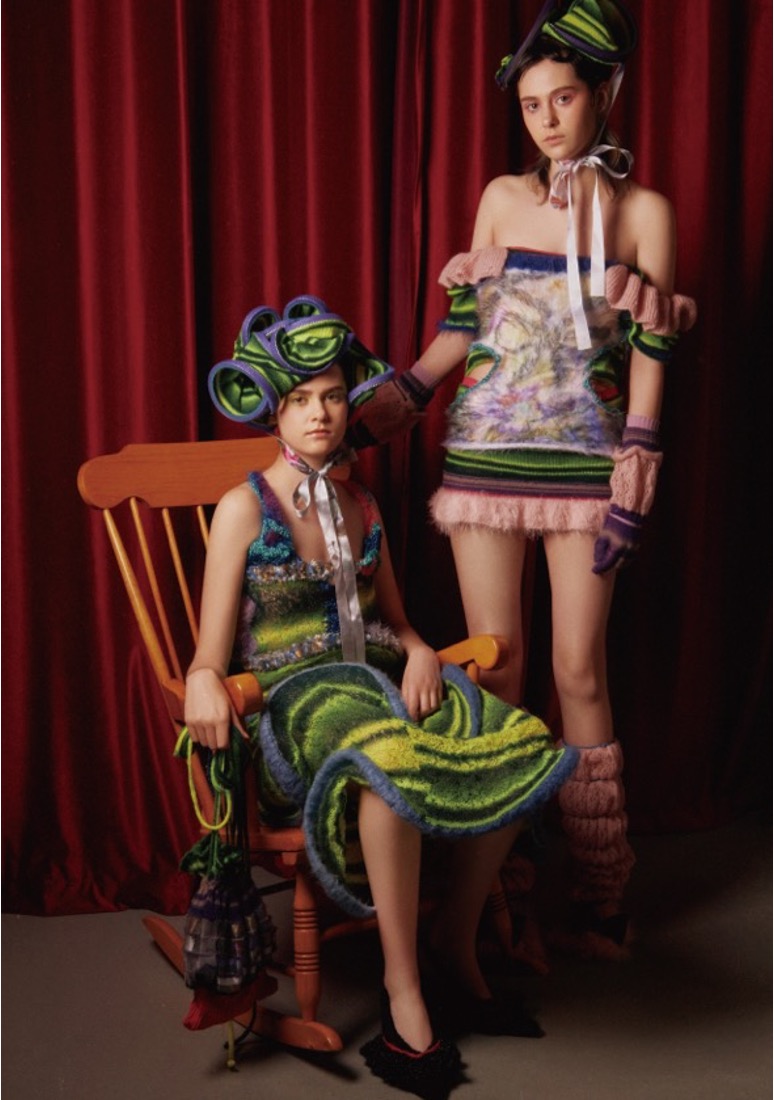
Charlotte Carter: ‘Shining a New Light on Knit’
Nottingham Trent University

Textile designer Charlotte’s interests lie in textile innovation and exploring meanings surrounding uncelebrated materials. Versatility and honesty in expression are important to her within this ambiguous, provocative collection. Charlotte explains of her collection ‘Shining a New Light on Knit’, “My project contains a vast range of experiments through my material exploration using unconventional combinations of materials and yarns such as steel, copper, heat set yarns, concrete and wax.”. Her domestic knitting machine allowed her more control when knitting with wire and other unconventional materials.

Discussing her material led explorations Charlotte explained, “My mission was threefold: to deconstruct the traditional perception of knit; identify the characteristics of knit; and challenge and redefine traditional interpretations, thus creating a new, contemporary perspective on what knit can be.” Understanding fibre characteristics and attempting to create form through knit were all a part of this exploration.
Charlotte explored relationships between light, movement and knit through abstract observations. Amongst her many interests she rekindled her love of photography during the creative process. Travelling with her camera post-graduation, Charlotte hopes to discover more of her interests before returning to potentially study an MA.
Charlotte’s Instagram: @put.a.sock.in.knit

Kemi Ajose : ‘Who Am I?’
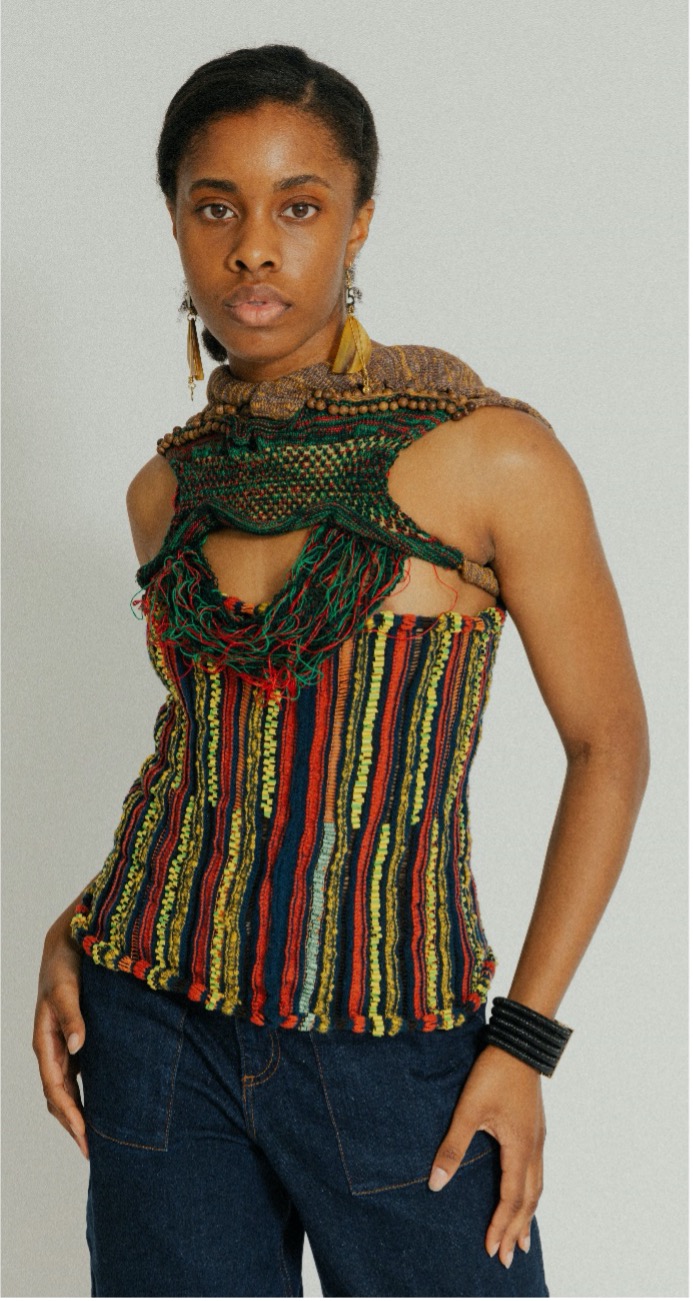
BA (Hons) Textile Design, UAL Central Saint Martins
Kemi’s graduate collection explores the craftsmanship of knitted textiles, utilising the body as a ‘blank canvas’ upon which narratives can be communicated. Enjoying problem solving through conscious, resourceful and practical decision making, Kemi shared the initial inspiration for her collection, “This project documents the Art of being resourceful. Through explorations in textile craftsmanship, I reconnected with where my generation is from, exploring the subconscious influence of my West African heritage. I narrated a story of the significance between material culture and craft to construct a hybrid identity.”
Research gathered from books, museums and artists fed into her narrative, “I took inspiration from artists and designers such as El Anatsui, Yinka Shonibare and J.D. Okhai Ojeikere, as well as using my own self as a muse. I reflected upon my personal experiences being a second-generation child, and how I embody my cultural background whilst being born and raised in London.”
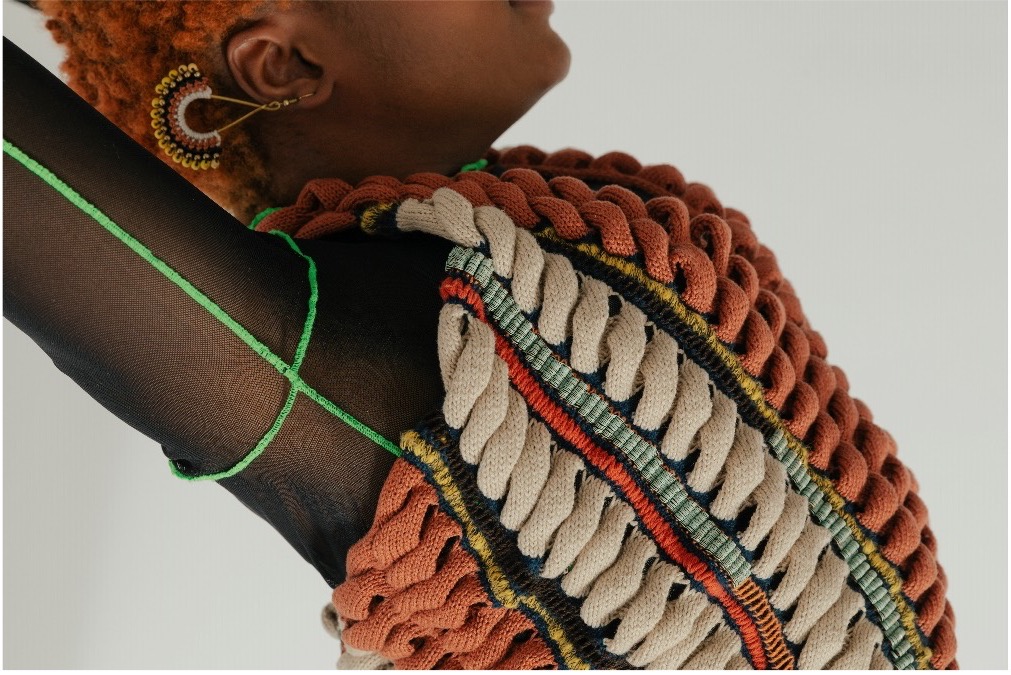
Kemi’s unique knitted outcomes showcase a variety of knitting skills. Using 7 gauge Dubied she created a bag using the ‘pockets’ technique, filling the pockets with broken zips and metal beads. Her ‘Transfer stitch waistcoat’ is a labour-intensive creation involving stitch transfers and partial knitting with cotton and wool. Her ‘Coiled Headpiece’ took a 3D mixed media approach inspired by coiled hairstyles and basketry techniques, wrapping wool around electrical wire cables. The two tops within Kemi’s collection explore elongated stitches, beading and partial knitting, pushing the boundaries of what domestic machine knitting can achieve.
Kemi’s collection was awarded the 2022 Clothworkers Material and Textile Award. Aspiring to one day launch her own brand, Kemi continues to showcase how West African colour and textures can be presented in the form of authentic, ready-to-wear knitwear.
Kemi’s Instagram: @Morenikeji_textiles
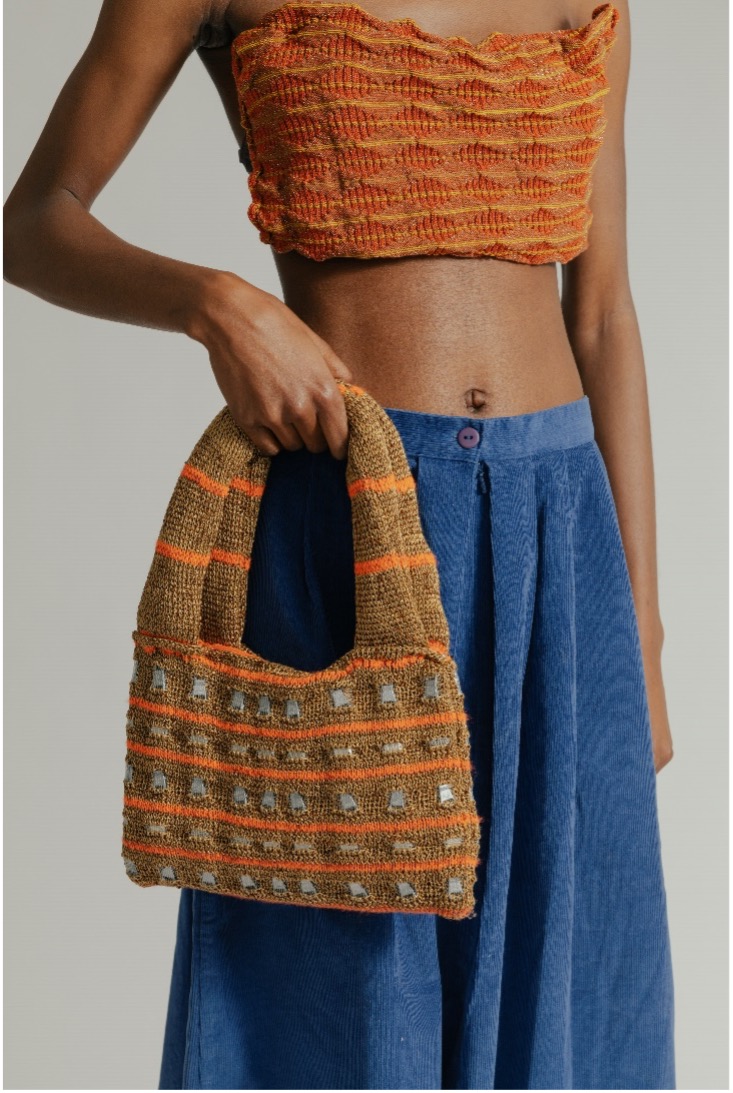
Lloyda Bangura : ‘Pokie’
BA (Hons) Fashion Textiles: Knit, UAL London College of Fashion
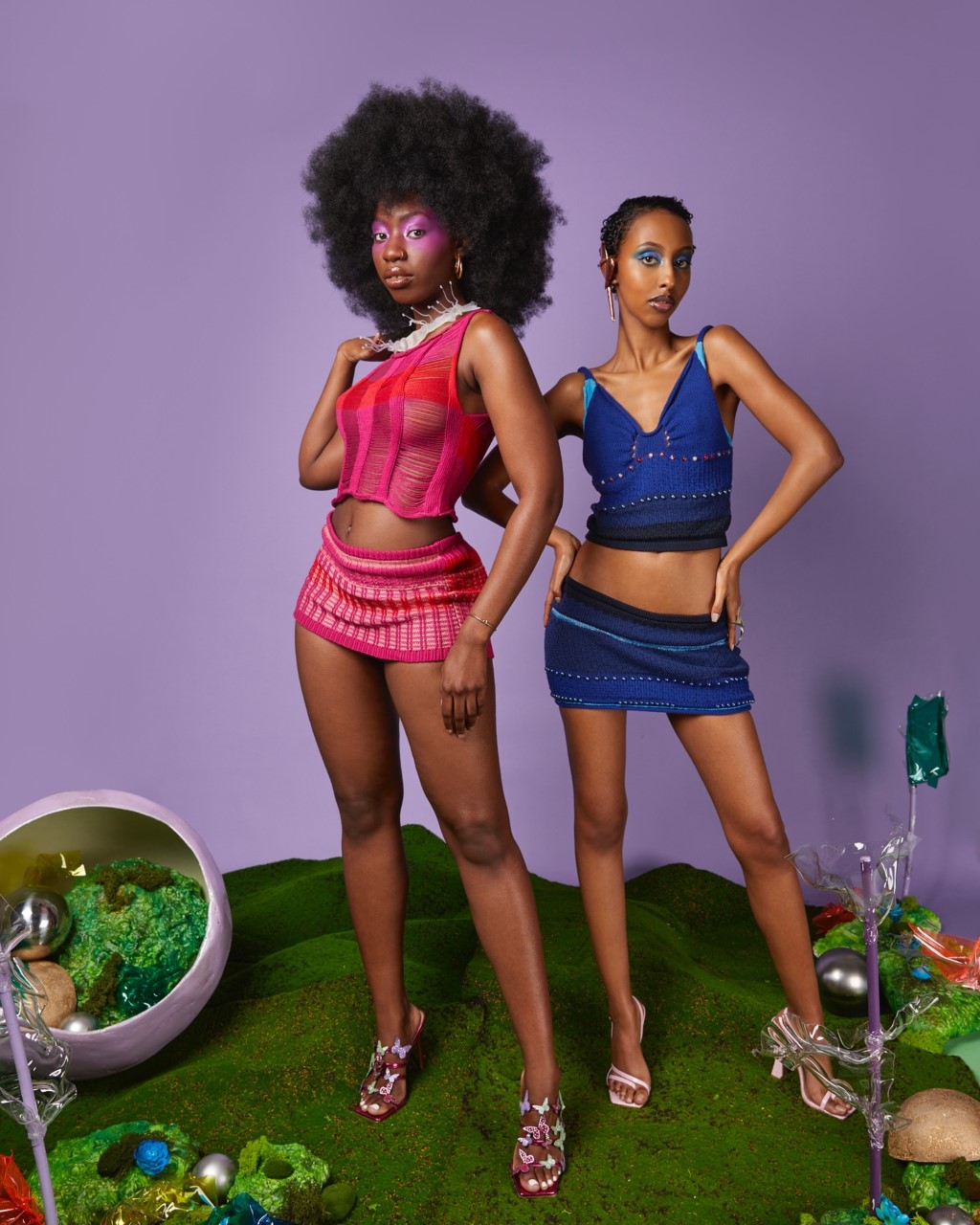
Knitwear designer Lloyda has transformed her childhood hobby of knitting into her own brand, designing and making bespoke ready-to-wear garments. Lloyda’s pieces are vibrant, personality filled creations. Based on Afrofuturism, Lloyda explained the influences upon which her collection was formed, “I was inspired by influences such as the bold, colourful, and textural wax fabrics my mother and ladies wore, which are often seen in my African west (Sierra Leonean) cultural heritage. I looked into traditional craft practices such as weaving, knitting and printmaking and brought to this a contemporary approach by exploring digital process too. I presented this through a futuristic and psychedelic viewpoint.”
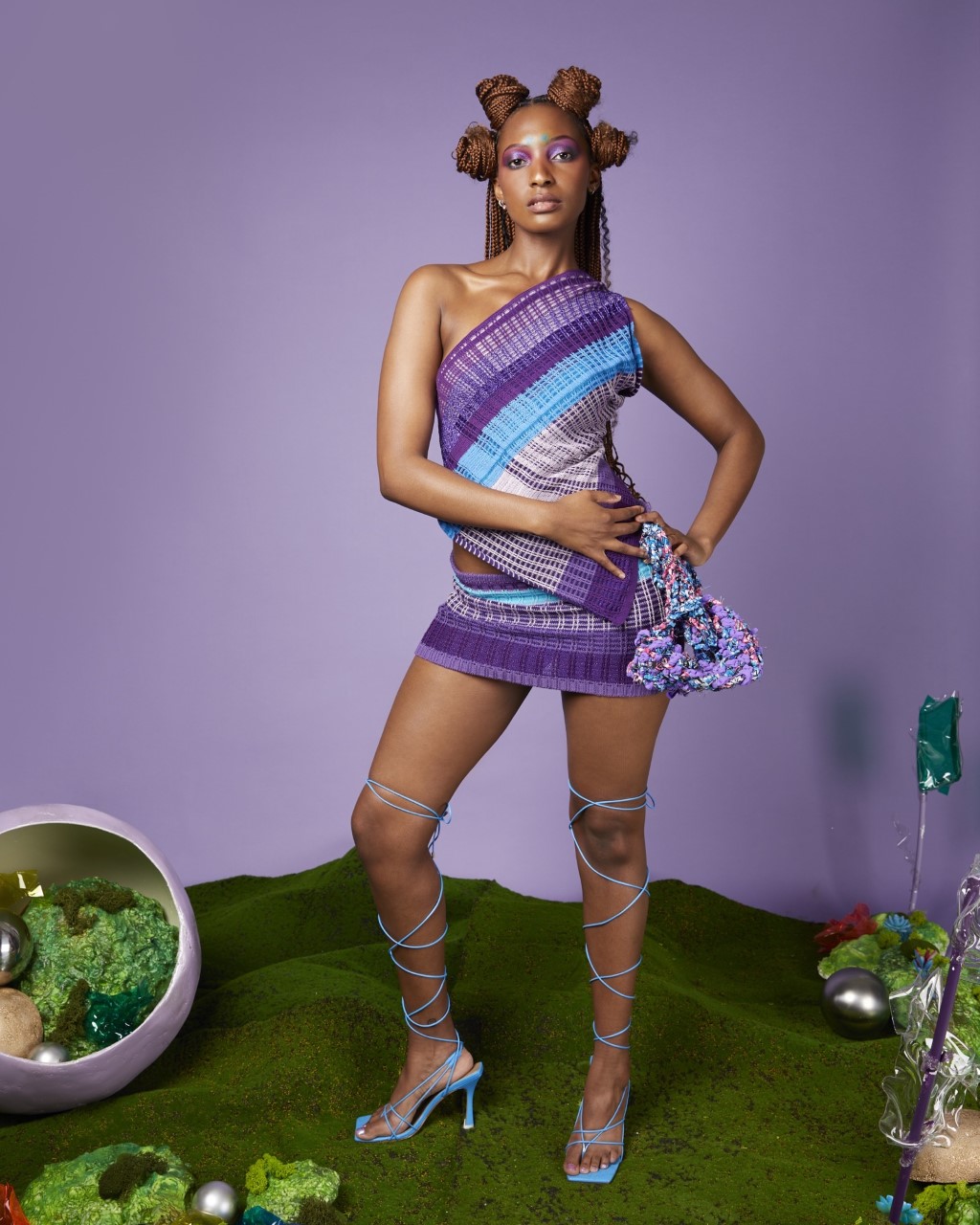
Lloyda has refined her yarn palette of viscose/cotton blends to generate her own uniquely identifiable aesthetic. Hand craft processes such as finger crochet and hand weaving were combined with domestic and Dubied machine knitting, as well as experiments with Stoll programming. Ladders, lace, partial knitting, transferring and weaving in are all featured techniques within the collection of knitted looks.
Lloyda plans to travel during the summer to gain inspiration for new projects. Upon return she hopes to establish her brand further and grow this business venture.
Lloyda’s Instagram: @lloyda_bangura
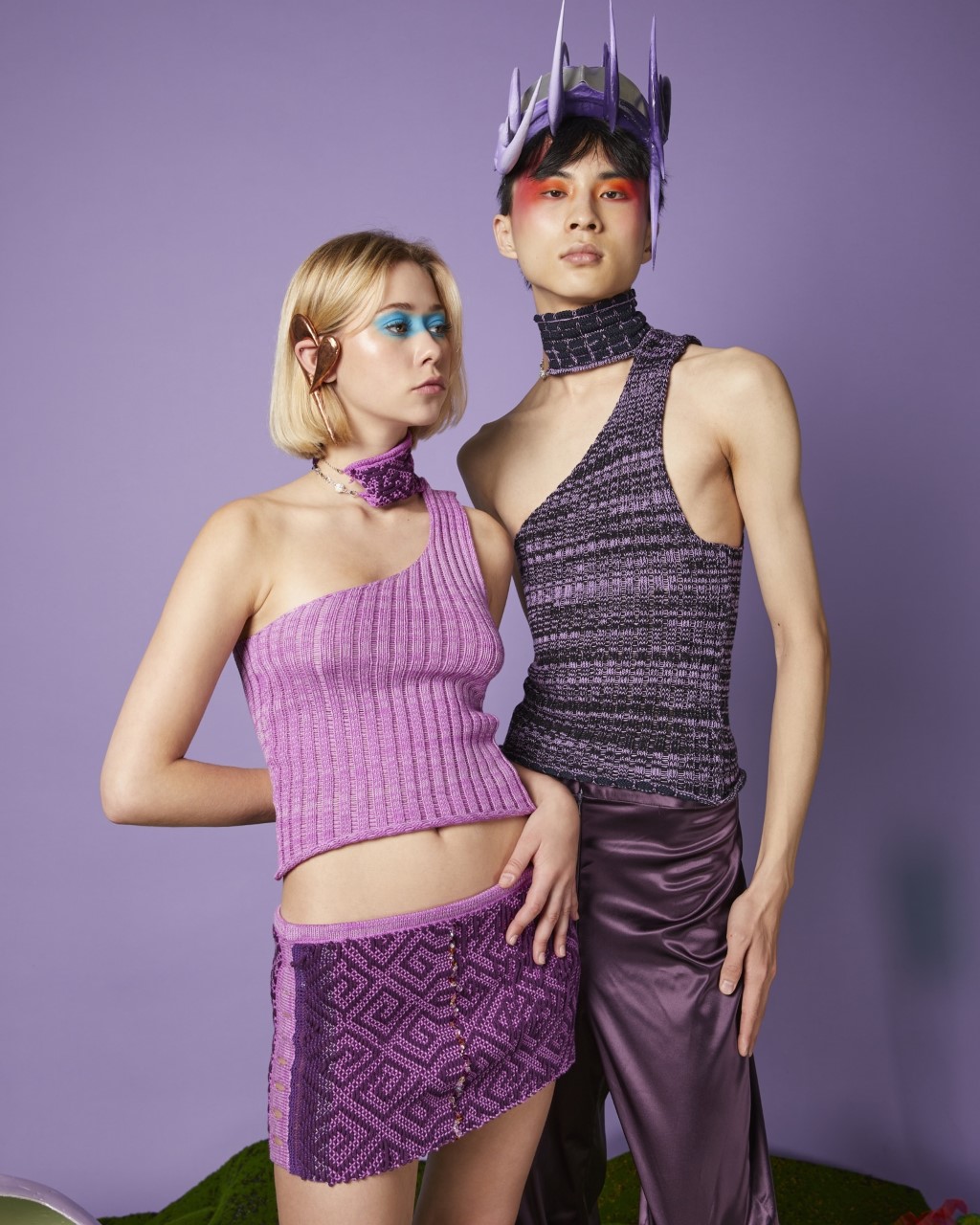

Subscribe To Our Newsletter
Join our mailing list to receive the latest news and updates from our team.



